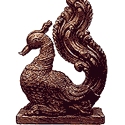
Arts, Painting, Domestic Arts/Crafts, Endangered Crafts, Festival Arts/Crafts
Sanjhi/Hand Cutting of Paper for Rangoli of Rajasthan
Asia Inch
Sanjhi Painting is an art form that arose from the Krishna cult and flourished in the north Indian state of Uttar Pradesh. This craft of Sanjhi painting achieved its peak in Vrindavan, Lord Krishna’s hometown. This folk art painting is rooted in the region’s culture. It rose to prominence in the 15th and 16th centuries due to Vaishnava temples.
‘Sanjhi’ is derived from words like “Sajja,” “Shringar,” and “Sajavat,” all of which mean “decoration.” According to legend, Radha, Krishna’s beloved, used to paint her walls with Sanjhi art to draw the attention of Krishna. She painted her newly plastered cow dung walls using coloured bricks, metal foils, and flowers. Seeing her, the other gopis of Vrindavan began painting walls with Sanjhi art in order to impress Krishna. Sanjhi paintings are made once a year to please Lord Krishna. Sanjhi is known as a highly sophisticated art form practised by Brahmin priests. The art of Sanjhi painting is currently practised by a small number of people and is only found in a few temples in India. The Radharamana temple in Vrindavan is one of these temples where Sanjhi paintings can still be seen.
Saanjhi Paper Art is a traditional style of stencilled paper cutting that serves as an outlet for artists to express their devotion to Krishna. To make a Sanjhi pattern, stencils are cut out of paper (usually by hand) with specially crafted scissors. These stencils are mounted on flat surfaces where the rangoli (threshold art) is to be drawn. The sand is then sifted with dry shades. Four of the most popular designs are peacocks, bullock carts, goats, pigs, butterflies, and trees. The artist’s commitment and intimate passion for Krishna is reflected in the exquisite craftsmanship. An intricate Sanjhi design could take anything from an hour to a month to complete.


